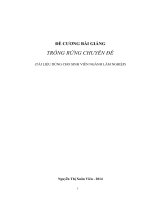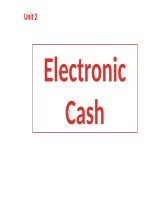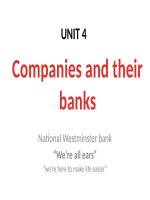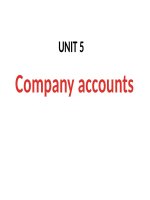unit 4 Bài giảng Anh văn chuyên ngành Tài chính Thư Viện Tài Liệu Tổng Hợp Com UNIT 4
Bạn đang xem bản rút gọn của tài liệu. Xem và tải ngay bản đầy đủ của tài liệu tại đây (510.72 KB, 12 trang )
4
AIMS:
Accounting
To learn about: types of accounting; financial statements; key
vocabulary of financial statements and accounting
To learn how to: say figures in English; talk about financial statements
To practise: presenting financial results
Lead in
o What is accounting? Why is it necessary for companies and organizations?
o Is there is one way of doing a business's accounts, or lots of different possible ways?
o What is auditing and why is it necessary?
Vocabulary 1
You are going to read a passage of Eric Sharp, a financial director, talking about
accounting. Before you read, check your understanding of the words and phrases in the
box by matching them with their definitions (1-10).
assets
liabilities
bookkeeping
financial accounting
expenditure
income
management accounting auditing
cost accounting
tax accounting
1. anything owned by a company - cash, buildings, machines, etc.
2. calculating how much tax an individual or a company should pay - or trying to reduce this
figure.
3. checking and evaluating financial records
Unit 4: Accounting
29
4. determining the unit cost of a manufactured product, including indirect costs
5. keeping financial records and preparing financial statements
6. money that a company will have to pay to someone else - bills, debts, interest, taxes, etc.
7. recording transactions (purchases and sales) in ledgers
8. the money that a company receives from supplying goods or services
9. the money that a company spends
10. the use of a company's accounting data by its managers for planning and control
Reading 1: Types of accounting
1. Eric Sharp presents the different branches of the accounting profession. What three
roles or areas of work does he mention?
In general, most of the boring work is done by purchase ledger clerks and sales ledger clerks.
These are usually bookkeepers who are not qualified to a high level. The information they
produce - which is basically a summary of transactions - can then be interpreted by management
accountants. It can then be used by senior accountants at financial controller and director level,
both for making decisions on the future of the business, and for advising other parts of the
business on how to proceed.
The company's accountants also do an internal audit. The aim of this tends to be to ensure
that management have sufficient internal control over what is going on. The aim of the external
audit is to ensure that published financial statements give a true and fair view of the company's
profit, and of its assets and liabilities.
2. Now read again and match the two parts of the sentences below.
1. Bookkeepers
2. Management accountants
3. Senior accountants at financial controller and director level
4. Internal auditing
5. External auditors
a. is about making sure that the management has sufficient control over what is going on
in the company.
b. do the boring work - recording transactions in purchase ledgers and sales ledgers.
c. have to verify that a company's published financial statements give a true and fair view
of its profit, its assets and its liabilities.
d. interpret the transactions recorded by bookkeepers.
e. use accounting data to make decisions about how the business should proceed.
Unit 4: Accounting
30
3. Which branches of accounting defined in Vocabulary 1 are not mentioned by Eric
Sharp? Would you be interested in working in these areas of accounting?
Reading 2: Financial statements
There are three or four different statements that companies include in their Annual Reports,
which shareholders can legally expect to see, The key documents are the profit and loss account,
the balance sheet, and a funds flow statement of some kind. In the USA, and under International
Financial Reporting Standards, the profit and loss account is called an income statement. This
document is fairly self-explanatory: it's income less expenditure. The balance sheet is a statement
showing what the company has, and what it owes at the end of the year, while the funds flow
statement attempts to show whether the company is generating or consuming cash. The tax
authorities require more detail than is given in these documents; taxable profit is not the same as
accounting profit, so they will expect to see reconciliations between the two.
Vocabulary 2
1. Investors and many people working in finance need to understand the basic terms in
financial statements. Decide which of the alternatives (a-c) each definition describes.
1. A charge for arranging a transaction (e.g. buying or selling securities)
a. commission
b. fee
c. tax
2. A charge for a service performed by a bank
a. commission
b. fee
c. tax
3. Payments for an insurance policy
a. commissions
b. premiums
c. tariffs
4. A reduction in the value of an asset, charged against profits
a. amortization
b. loss
c. waste
5. Adjective meaning after all deductions have been made
a. gross
b. net
c. zero
6. Adjective meaning for a whole group of companies
a. consolidated
b. corporate
c. mutual
7. Adjective meaning one year or less in financial statements
a. annual
b. long-term
c. short-term
8. Part-ownership (less than 50%) of other companies
Unit 4: Accounting
31
a. conglomeration
b. liabilities
c. minority interests
9. Things of value that cannot be physically touched, such as reputation (goodwill), brand
names and trademarks
a. intangible assets
b. liabilities
c. tangible assets
10. The net worth of a company - the amount by which assets exceed liabilities
a. dividends
b. profit
c. shareholders' equity
2. Now look at the income statement from Barclays Bank, and complete it using answers
from Vocabulary 2. Some words can be used more than once.
Unit 4: Accounting
32
Financial ratios
Unit 4: Accounting
33
Language focus
Talking about figures 1
In British English, and is used after hundred when saying figures; in American English it is not.
Example: 1,234,567,890
(British English) one billion, two hundred and thirty-four million, five hundred and sixty seven
thousand, eight hundred and ninety
(American English) one billion, two hundred thirty-four million, five hundred sixty-seven
thousand, eight hundred ninety
Barclays' consolidated statements are expressed in millions of pounds sterling; to get the total
figure you need to add six zeros. For example, their operating expenses were £10,527,000,000:
ten billion, five hundred (and) twenty-seven million pounds. These large figures can also be said
as decimals: ten point five two seven billion pounds.
See Unit 9 for more on saying decimal numbers.
1. Work in pairs and take turns to test your partner. One person finds one of the following
figures from the income statement, and reads it out. The other person says which figure
(1-6) it is. Use a calculator if you need to.
1. the largest figure
2. the largest negative figure (in brackets]
3. total income over the two years
4. total net profit over the two years
5. total tax paid over the two years
6. the increase in operating expenses since the previous year
2. Work in pairs. Ask your partner how much time, in hours or minutes, they think they
spend in an average week doing the following things:
1. working
5. sleeping
2. working in English
6. watching television
3. using a computer
7. waiting at red traffic lights.
4. eating
3. Calculate how many seconds they spend on each activity per year. Read out the figures
while your partner writes them down, and then check that you both have the same
figures.
Unit 4: Accounting
34
Reading 3: Barclays' balance sheet
Look at the balance sheet below and then read the passage about the bank. Make notes on what
the passage presents, and fill in the five missing figures.
Unit 4: Accounting
35
Large banks these days really do possess and manage vast sums of money. For example,
Barclays' tangible assets - the buildings the banks are in, and so on, recorded in the accounts as
property, plant and equipment - are only worth two point seven five four billion, but the group's
total worth, or their shareholders' equity, is twenty-four point four three billion. Their total assets
are nine hundred and twenty-four billion, three hundred and fifty-seven million pounds.
Barclays' customers have deposited two hundred and thirty-eight billion, six hundred and eightyfour million pounds in their accounts, and the bank has advanced or lent its customers two
hundred and sixty-eight billion, eight hundred and ninety-six million pounds. These really are
huge figures.
Choose the best answer:
1. …………. is an organized market for the issue of new securities and the exchange of the
second-hand ones
A. open market
B. partnership
C. stock exchange
D. corporate
2. …………..is an association of two or more people who come together to run a business.
A. company secretary
B. ownership
C. partnership
D. shareholder
3. ………….is a business formed by a group of people using money provided by all of them .
A. joint stock company
B. partnership
C. manufacturing
D. merchandizing
4. Using all available accounting procedures and tricks to disguise the true financial position of
a company is ……………….
A. creative accounting
B. bookkeeping
C. managerial accounting
D. cost accounting
5. Writing down the details of transactions (debits and credits) is ………….
A. auditing
B. bookkeeping
C. managerial accounting
D. cost accounting
6. Inspection and evaluation of accounts by a second set of accountants is ………..
A. auditing
B. bookkeeping
C. managerial accounting
D. cost accounting
7. ………….is all the money received by a company during a given period.
A. Revenue
B. Shareholder
C. Overhead
D. Stock
8. ………….is all the money that a company will have to pay to someone else in the future,
including taxes, debts, and interest and mortgage payments.
A. Revenue
B. Liability
C. Overhead
D. Stock
Unit 4: Accounting
36
9. The …………………must set up and understand the entire system of records so that he or
she can analyze and interpret business transactions.
A. accountant
B. bookkeeper
C. qualified person
D. controller
10. …………….. is chiefly concerned with determining the unit cost of the products the
company manufactures and sells.
A. Cost accounting B. Managerial accounting C. Public accounting
D. Tax accounting
11. ………… is the review of an organization’s financial records by an accountant.
A. Audit
B. Purchase
C. Direction
D. Institution
12. The duty of the bookkeeper is that he or she simply ……………
A. sets up a bookkeeping system
B. interprets the data in the bookkeeping system
C. performs the routine work
D. enters the data in the financial records
13. …………….are of course in business for some purpose other than making money.
A. Manufacturing businesses
B. Non profit organizations
C. Business enterprises
D. Service businesses
14. Non profit organizations include ……………
A. religious groups, symphony orchestras, and charitable societies.
B. dental practice, laundry, and bakery.
C. Cotton mill, toy factory, and bakery.
D. Souvenir shop, clothing store, and department store.
15. …………….are things of value that are owned by a company.
A. Assets
B. Liabilities
C. Owners’ Equity
D. Revenues
16. Assets of a business include: ………………
A. cash, receivable, property, and owners’ equity.
B. cash, checks, intangible, and proprietorship.
C. money order, receivable, tax and tangible
D. cash, receivable, property and intangible.
17. ……………refer to owner’s equity, or assets minus liabilities.
A. Net assets
B. Net income
C. Assets
18. Which of the following is a liability account ?
A. Accounts receivable B. Drawings
payable
C. Rent expense
D. Revenues
D.
Accounts
19. Decrease in mortgage account should be recorded by …………..
A. a debit
B. a credit
C. footing
D. trial balance
20. Accounts receivable are ………….
A. Current assets
B. Fixed assets
C. Current liabilities
D. Capital
21. Income accounts are increased on ---------A. the credit side
B. the debit side
C. trial balance
D. Entry
Unit 4: Accounting
37
22. The book that lists all the accounts of an organization is the -----------A. Journal
B. Ledger
C. Cash report
D. Balance sheet
23. Decrease in the telephone (expense) account is recorded as --------A. a debit
B. a credit
C. trial balance
D. Entry
24. Assets = Liabilities + Owners’ Equity is ………….
A. the accounting equative
B. the basis accounting formula
C the basic accounting equation
D. the salary basis
25. The left side of an account is referred to as …………..
A. the balance
B. a credit
C. a debit
D. a footing
26. Although debits may be used to increase assets, they may also be used to ……….
A. decrease assets
B. increase OE
C. increase expenses
D. increase liabilities
27. The payment of liabilities will…………….
A. increase both assets and liabilities
C. decrease assets and increase liabilities
B. increase assets and decrease liabilities
D. decrease assets and decrease liabilities
28. An agreement to spend $200 a month on advertising beginning next month requires…………
A. a debit to advertising expense
B. a debit to prepaid advertising
C. no entry
D. a credit to cash
29. The right side of an account is referred to as …………..
A. the balance
B. a credit
C. a debit
D. a footing
30. Which of the following is an asset account ?
A. Office equipment
B. Purchases
C. Sales
D. Drawings
31. Another term used for Capital is ……….
A. abbreviate
B. mortgage
C. proprietorship
D. fixture
32. The investment in an organization or business by the owner or owners is called ……………..
A. transaction
B. capital
C. loan
D. purchase
33. ……………is an obligation that is owed by an organization.
A. Capital
B. Account
C. Liability
D. Debit
34. The resulting profit or loss is posted to ___________
A. A capital account
B. An asset account
C. A liability account
D. An Income account
35. .............is done by accountants who are not employees of the organization whose books they
examine.
A. independent auditing
B. internal auditing
C. audit standard
D. internal auditor
Unit 4: Accounting
38
36. Economics events that affect the financial position of a business are called …………
A. separate entities
B. money measures
C. business transactions
D. financial actions
37. The ability to earn enough income to attract and hold investment capital is known as
………..
A. owner’s investment
B. profitability
C. owner’s withdrawals
D. revenues
38. ………….means having enough funds on hand to pay debts when they are due.
A. Liquidity
B. Money measure
C. Financial position D. Due care
New words:
settle (v)
: giải quyết, thanh toán, kết toán, trả dứt
settlement (n)
: việc giải quyết, việc thanh toán
restate (v)
: tuyên bố lại
to accuse of
: tố cáo về
bankrupt (adj/v) , bankruptcy (n)
: phá sản, vỡ nợ
dive (v)
: lặn
audit (v)
: kiểm toán
auditor (n)
: kiểm toán viên
auditing (n)
: việc kiểm toán
internal auditing
: kiểm toán nội bộ
external auditing= independent auditing
: kiểm toán ngoại bộ
definition (n)
: định nghĩa
expenditure (n)
: việc chi tiêu
cost accounting
: kế toán giá thành
management accounting
: kế toán quản trị
reduce (v)
: giảm bớt
evaluate (v)
: đánh giá
unit cost
: giá thành đơn vị
manufacture (v)
: sản xuất, chế tạo
direct cost (n)
: chi phí trực tiếp
indirect cost (n)
: chi phí gián tiếp
debt (n)
: nợ
purchase
: (v) mua hàng ,(n) hàng mua
ledger (n)
: sổ cái
Unit 4: Accounting
39
senior accountant (n)
: kế toán viên cao cấp
bookkeeper (n)
: người giữ sổ sách, nhân viên kế toán
financial controller (n)
: kiểm soát viên tài chính
sufficient (adj)
: đầy đủ
verify (v)
: xác minh, thẩm tra
interpret (v)
: diễn giải
transaction (n)
: giao dịch
proceed (v)
: tiếp tục, tiến lên
explain (v)
: giải thích
explanatory (adj)
: giải thích
fair (adj) Æ fairly (adv)
: hợp lý, công bằng
balance sheet (n)
: bảng cân đối
funds flow statement (n)
: bảng vốn và sử dụng vốn
shareholder (n)
: cổ đông
consume (v)
: tiêu thụ
attempt (v)
: cố gắng
taxable profit (n)
: lợi nhuận chịu thuế
reconcile (v)
: làm cho phú hợp
reconciliation (n)
: sự điều chỉnh, sự đối chiếu
premium (n)
: phí bảo hiểm, tiền thưởng
amortization (n)
: việc trả dần, việc khấu hao dần
deduct (v)
: trừ đi , deduction (n)
corporate (adj)
: (thuộc về) công ty
tangible assets
: tài sản hữu hình
intangible assets
: tài sản vô hình
goodwill (n) = reputation
: uy tín kinh doanh, danh tiếng của cơ sở KD
consolidated (adj)
: hợp nhất
impairment (n)
: sự sút kém, sự hư hỏng
joint venture (n)
: liên doanh
derivative (adj)
: phát sinh
eligible bill
: phiếu khoán ngân hàng hợp thức
senior (adj)
: cấp trên, cao cấp
………………………………………………………………………………………………………………………..
………………………………………………………………………………………………………………………..
Unit 4: Accounting
40









